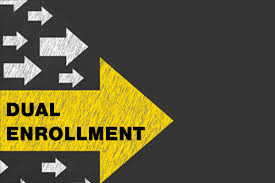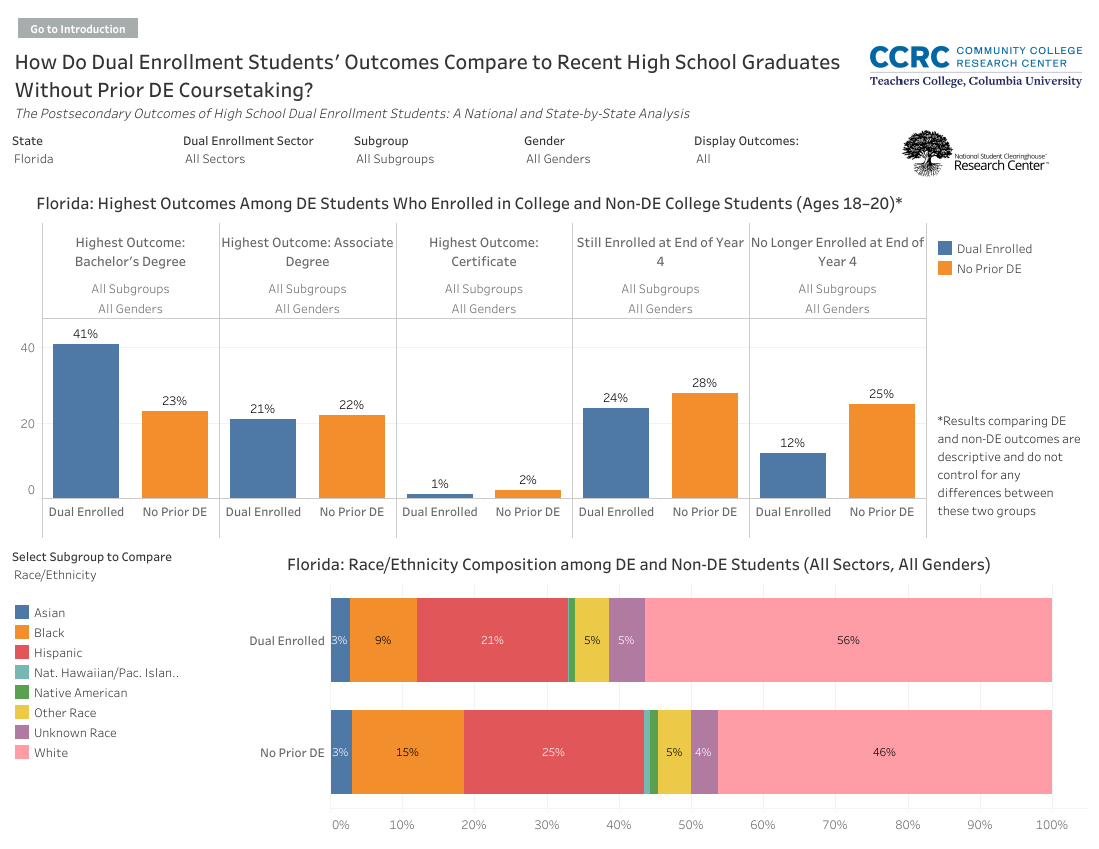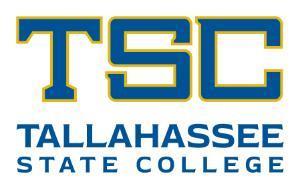- Leon County Schools
- Dual Enrollment
Student Services
Page Navigation
-
Dual Enrollment Programs: The Pros and Cons
 As juniors across the country begin planning for next year’s courses, many are considering a dual-enrollment or concurrent enrollment class. Dual-enrollment classes enable high school students to take classes at a local college and potentially earn college credit.
As juniors across the country begin planning for next year’s courses, many are considering a dual-enrollment or concurrent enrollment class. Dual-enrollment classes enable high school students to take classes at a local college and potentially earn college credit.There are many benefits to dual-enrollment programs. Earning college credit while still in high school sounds like a dream for many students. In addition, these programs introduce students to the rigors of college coursework early, and recent studies have shown that students who participate in dual-enrollment programs are more likely go on to get a college degree. But is dual enrollment right for your child?
Why Should My Child Consider a Dual-Enrollment Program?
- Dual enrollment gives students an idea of what full-time college coursework will be like, says StudyPoint. By trying out a few classes while still in high school, your child can get used to the academic environment before he or she leaves the comfort and support of home.
- Your child may be able to take classes that aren’t offered at his or her high school.
- College courses can give your student a closer look at his or her area of academic interest. If your child is currently loving AP history, a college course next year on the Civil War or the Great Depression will help him or her explore that period in greater depth and precision.
- According to collegeboard.com, most students change their majors at least once. Taking a college class as a high school senior can help your child find his or her area of interest before the pressure is on to declare a major.
- If your student didn’t qualify to take AP courses, or if those courses weren’t available at your child’s high school, taking a college-level class will help him or her demonstrate the ability to handle more difficult coursework, according to StudyPoint. This ability is something every college admissions officer wants to see.
- Due to the large number of online and virtual classes offered by many schools, dual-enrollment courses may be conducted right at your child’s high school, says StudyPoint. Ask your student’s guidance counselor about dual-enrollment options in your area.
- Perhaps the biggest benefit of dual enrollment is that your student may start accumulating college credits, helping him or her graduate on time or even early.
Dual Enrollment Sounds Great! Is There Any Reason My Child Shouldn’t Participate?
- If a course is already available at your child’s school, it might be best to take it there. Colleges may wonder why a student has chosen to take an intro class at a community college if there’s an AP class in the same subject available at the high school level. (High school AP classes may well prove more challenging than an intro-level college course.) If the college course won’t give your student something above and beyond what’s available at his or her high school, take a pass.
- If a college class will interfere with your child’s regular coursework or extracurriculars, it may not be a good idea. A college course should enhance a student’s resume, but not at the expense of other resume-enhancing activities. When considering scheduling, be sure to take into account not just the normal class schedule but breaks as well; your local high school and community college may not operate on the same academic calendar. A different holiday schedule could cause conflicts with class trips, family vacations, or out-of-town athletic commitments.
- A college course in music appreciation is a great resume booster—as long as your child plans to go into music. If he or she is planning a career in chemistry, the music class won’t help, and could raise questions about the academic rigor of your child’s senior year courses. Carefully consider the academic value of any class your child is considering.
- Dual-enrollment courses are real college courses for real college credit; the grades will go on your student’s permanent record. Before enrolling, make sure your student is ready for the demanding work a college class will require, or it could hurt his or her chances at college acceptance down the line. Furthermore, if a student fails a dual-enrollment course, it could mean he or she won’t graduate high school on time.
- If your child is considering a dual-enrollment program for the purpose of earning college credits, be sure of the value of the credits. For each college where your child may apply next year, check to see how many credits (if any) a dual-enrollment class would earn your child. The credit policy will depend on the school.
Where Should We Start?
- Students should check with their high school guidance counselors to find out if they qualify. Students will also need permission from parents/guardians and a guidance counselor or principal.
- Your child’s guidance counselor will also be able to provide information about financial obligations. Many states pay for dual enrollment; in other states, students must pay.
DE vs Non-DE Outcomes

-
High School Acceleration Programs
Advanced Placement
- Course Information
- Professional Development Opportunities
- For AP Coordinators
- AP Exam ordering deadlines
- Phone: 888-225-5427 (toll free in the United States and Canada) or 609-771-7300 apexams@info.collegeboard.org
- For Teachers
- For AP Coordinators
- SAT Program (PDF)
- PSAT (PDF)
- For Students, Parents, and Educators
- Florida Contact:
Brian Barnes, Senior Director, College Board Partnerships
The College Board
1545 Raymond Diehl Road, Suite 250
Tallahassee, FL 32308
Phone: 850-521-4905
Fax: 850-521-4921
dshepard@collegeboard.org
International Baccalaureate
- International Baccalaureate
- Course Information
- Teacher Professional Development Information
- Florida Contact:
Karen Brown
850-767-4514
State Headquarters:
3303 Thomasville Road, Suite 101
Tallahassee, FL 32308
Telephone: (888) 590-3999
Fax: 850-391-6212
E-mail: info@flibs.org
Website: http://www.flibs.org
Dual Enrollment
- General Information
- Dual Enrollment Statement of Standards (PDF)
- Dual Enrollment Course-High School Subject Area Equivalency List (PDF)
- Memo on Approved Dual Enrollment Credit for University of Florida Programs
- Memo on Approved Dual Enrollment Credit for Boys State, Girls State, and the Lou Frey Institute of Politics and Government Civic Leadership Academy (PDF)
- Teacher Professional Development Information
Contacts:
Matthew Bouck
Office of Articulation
Florida Department of Education
850-245-9544
Julie Alexander
Division of Community Colleges
Florida Department of Education
850-245-0407
Julie.Alexander@fldoe.org
LTC - Dual Enrollment
-
 Focus on Getting Ahead! - Launch your Career Early with Dual Enrollment
Focus on Getting Ahead! - Launch your Career Early with Dual EnrollmentHigh school students can earn elective credits AND gain valuable career skills at the same time! Our Career Dual Enrollment Program offers pathways in Architecture & Construction, Health Sciences, Manufacturing, Transportation, Distribution, etc. Get a head start on your future, save on tuition, and graduate with a competitive edge.
Career Dual Enrollment opportunities are open to all Leon County full-time high school students, age 16 years or older and have earned at least 11 credits. Transportation from your home high school to Lively Technical College will be your responsibility. Prospective students should see their home high school guidance counselor to discuss Career Dual Enrollment options.
Learn more at www.livelytech.com/students/dual-enrollment/ or contact 850-487-7431. Your future starts now!
Contacts:
Sherbah Carey: careys@leonschools.net
850.487.7431
LTC Dual Enrollment FIles
TCC - Dual Enrollment
-

Take challenging courses and accelerate your education opportunities. Dual Enrollment lets motivated high school students take classes that satisfy high school graduation requirements and count as college credit toward a college degree.
Dual Enrollment students are able to take classes:- On the TSC campus
- On the High School campus
- Or Online
Traditional dual-enrolled students can take a maximum of 11 credit hours each semester. Early admission students can take a minimum of 12 credit hours and a maximum of 15 credit hours each semester. Special permission is required each semester for the early admission program.
TSC Dual Enrollment Files
FSU - Dual Enrollment
-
 High School Dual Enrollment is a coursework acceleration program that allows qualified high school students to begin postsecondary coursework while earning credits toward their high school diploma.
High School Dual Enrollment is a coursework acceleration program that allows qualified high school students to begin postsecondary coursework while earning credits toward their high school diploma. Participation in High School Dual Enrollment has several advantages for students planning to pursue a college degree. It allows qualified students the opportunity to take college classes, free of tuition and fees, while they are still in high school. These students will have access to rigorous post-secondary courses while reducing the time and cost of completing the college degree.
Note: Students taking dual enrollment courses must recognize that dual enrollment course grades will become a permanent part of the college transcript and will be factored into future applications to other colleges and universities. Therefore, dual enrollment students are expected to work closely with the Academic Center for Excellence (ACE) faculty and staff for ongoing academic advisement and support.
FSU Dual Enrollment Files
FAMU Dual Enrollment
-
 High School Dual Enrollment is a coursework acceleration program that allows qualified high school students to begin postsecondary coursework while earning credits toward their high school diploma.
High School Dual Enrollment is a coursework acceleration program that allows qualified high school students to begin postsecondary coursework while earning credits toward their high school diploma. Participation in High School Dual Enrollment has several advantages for students planning to pursue a college degree. It allows qualified students the opportunity to take college classes, free of tuition and fees, while they are still in high school. These students will have access to rigorous post-secondary courses while reducing the time and cost of completing the college degree.
Note: Students taking dual enrollment courses must recognize that dual enrollment course grades will become a permanent part of the college transcript and will be factored into future applications to other colleges and universities. Therefore, dual enrollment students are expected to work closely with the Academic Center for Excellence (ACE) faculty and staff for ongoing academic advisement and support.


